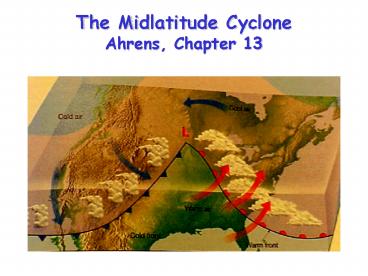The Midlatitude Cyclone Ahrens, Chapter 13 - PowerPoint PPT Presentation
1 / 23
Title:
The Midlatitude Cyclone Ahrens, Chapter 13
Description:
3. Flow associated with low SLP leads to cold/warm advection in lower troposphere. 4. Temp advection increases upper level trough, which leads to even more divergence. ... – PowerPoint PPT presentation
Number of Views:72
Avg rating:3.0/5.0
Title: The Midlatitude Cyclone Ahrens, Chapter 13
1
The Midlatitude CycloneAhrens, Chapter 13
2
Large-Scale Setting Hemispheric westerlies
typically organized into 4-6 long waves Where
is upper level divergence most likely to occur?
3
A Family of Cyclones
4
Vorticity Cyclone Spin
Figure 13.18
Figure 13.19
Vorticity describes the spin of an air parcel,
which is positive in counterclockwise cyclonic
flow. Due to the conservation of angular
momentum, vorticity increases with a decrease in
parcel radius (e.g. stretching due to divergence
aloft) and increase in earth's latitude.
5
(No Transcript)
6
Convergence and Divergence
What initiates cyclogenesis?
When upper-level divergence is stronger than
lower-level convergence, more air is taken out at
the top than is brought in at the bottom. Surface
pressure drops, and the low intensifies, or
deepens.
500 mb height
7
(No Transcript)
8
Upper Air/Surface Relationship
9
(No Transcript)
10
The Wave Cyclone Model(Norwegian model)
- Stationary Front
- Nascent Stage
- Mature Stage
- Partially Occluded Stage
- Occluded Stage
- Dissipated Stage
11
Lifecycle of a Midlatitude Cyclone
Green shading indicates precipitation Takes
several days to a week, and moves 1000s of km
during lifecycle
12
- Cyclone Development
- baroclinic instability (baroclinic means
temperature varies - on an isobaric surface) causes initial
perturbation to grow. - occurs in the presence of strong temperature
gradients. - Imagine a short wave trough passes overhead
(looking North) - Where will surface low develop?
east
13
(looking North) Near the surface, where will
we have cold and warm advection? Will this
amplify or weaken the upper level low? How about
the upper level divergence? Will a more intense
upper level low strengthen or weaken the
surface low?
High
High
Low
DIV
Low
DIV
warm
cool
Low
east
14
Cyclone initiation Passage of a shortwave often
initiates the formation of a surface low.
15
Cyclone development Strong north south
gradientpassage of a shortwave trough Can lead
to rapid cyclogenisis via baroclinic
instability (baroclinic means temperature varies
on an isobaric surface)
16
Cyclone Development
17
What maintains the surface low?
Imagine a surface low forming directly below
upper level low
Surface convergence fills in the low
Surface divergence undermines the high
18
Actual vertical structure Upper level low is
tilted westward with height with respect to the
surface. UPPER LEVEL DIVERGENCE INITIATES AND
MAINTAINS A SURFACE LOW.
19
Baroclinic Instability
- Upper level shortwave passes
- Upper level divergence -gt sfc low
- Cold advection throughout lower troposphere
- Cold advection intensifies upper low
- Leads to more upper level divergence
Temperature advection is key!
20
1. Divergence aloft 2. Leads to lower SLP
underneath divergence 3. Flow associated with low
SLP leads to cold/warm advection in lower
troposphere. 4. Temp advection increases upper
level trough, which leads to even more divergence.
21
Intensification occurs typically just ahead of
upper air trough axis.
22
(No Transcript)
23
Questions to Think About
- What is the vertical structure of a developing
storm? - Where is the strongest upper/lower level
divergence/convergence occurring? - Why arent the lows vertically stacked?
- What is required for a storm to develop?
- Where is rising motion occurring?
- Where is precipitation occurring?
- What is the ultimate source of energy for a
midlatitude storm? - Why does a storm die?
- During what time of year would you expect more
midlatitude cyclones? - Why doesnt baroclinic instability occur in the
tropics?































